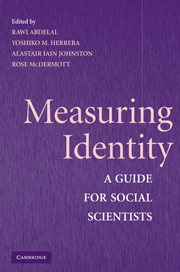Book contents
- Frontmatter
- Contents
- Contributors
- Introduction
- I DEFINITION, CONCEPTUALIZATION, AND MEASUREMENT ALTERNATIVES
- II SURVEY METHODS
- III CONTENT ANALYSIS AND COGNITIVE MAPPING
- IV DISCOURSE ANALYSIS AND ETHNOGRAPHY
- 10 Identity Relations and the Sino-Soviet Split
- 11 Techniques for Measuring Identity in Ethnographic Research
- V EXPERIMENTS
- Bibliography
- Index
11 - Techniques for Measuring Identity in Ethnographic Research
Published online by Cambridge University Press: 05 June 2012
- Frontmatter
- Contents
- Contributors
- Introduction
- I DEFINITION, CONCEPTUALIZATION, AND MEASUREMENT ALTERNATIVES
- II SURVEY METHODS
- III CONTENT ANALYSIS AND COGNITIVE MAPPING
- IV DISCOURSE ANALYSIS AND ETHNOGRAPHY
- 10 Identity Relations and the Sino-Soviet Split
- 11 Techniques for Measuring Identity in Ethnographic Research
- V EXPERIMENTS
- Bibliography
- Index
Summary
IDENTITY IN ETHNOGRAPHIC RESEARCH
In anthropology and sociology, as in much of clinical and social psychology, the question of identity is so central that it would be an overwhelming task to review the literature or to try to summarize how ethnographers “define” identity. However, for the purposes of this chapter, I will put forth a working definition that is shared by many social scientists and review the way that identity has been measured in a select but diverse group of ethnographic studies. As many of the authors in this book have pointed out, the foundation of the concept of identity is that it is inherently a relational phenomenon: “self” is primarily defined in relation to “other.” The definition I use for collective identity is a reflexive self-understanding of group belonging. The modifier “reflexive” draws our attention to the mutable nature of identity, which can be reevaluated at any time without being inauthentic. I explicitly contrast identity with categorization, a definition that is externally applied to a group, which becomes identity only when it is internalized. An understanding of “groupness” that is not reflexive, such as a division of humanity into three racial types, is a categorization rather than an identity. Reflexivity also brings an element of self-awareness and agency into the definition of identity, recognizing that identities require at least some degree of conscious reproduction.
- Type
- Chapter
- Information
- Measuring IdentityA Guide for Social Scientists, pp. 316 - 342Publisher: Cambridge University PressPrint publication year: 2009
- 12
- Cited by



